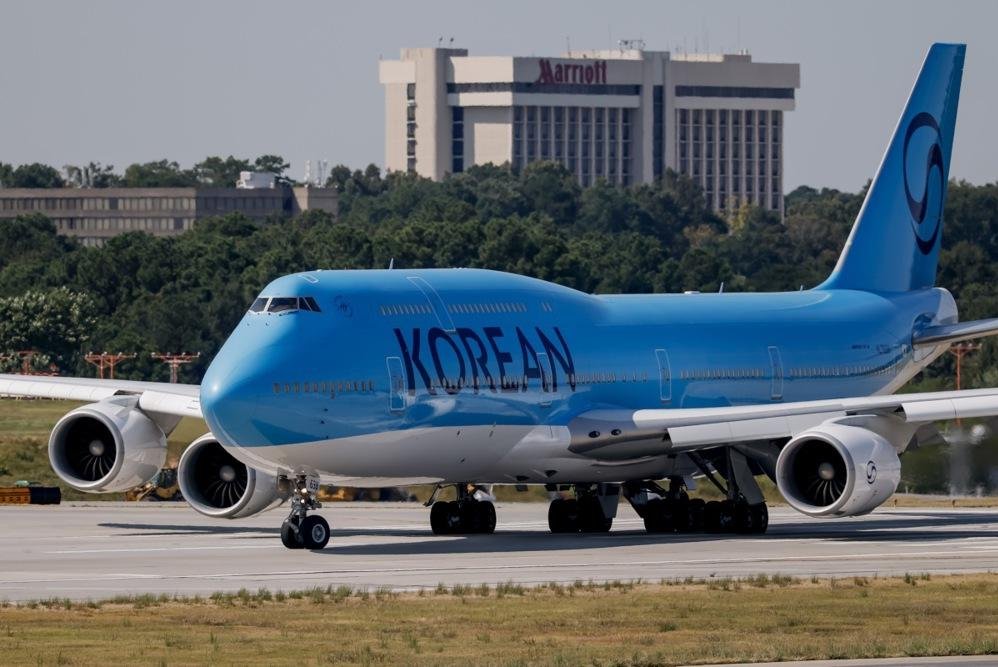A Korean Air Lines Boeing 747-800 charter flight departs for Seoul with previously detained Korean workers from Hartsfield Jackson Atlanta International Airport in Atlanta on Thursday. Photo by Erik Lesser/EPA
SEOUL, Sept. 11 (UPI) — The shock of the “mass detention of 316 Koreans” in Georgia was eventually eased as arrangements were made for their return. According to Seoul, 316 Korean workers are scheduled to arrive in Incheon on Friday about 4 p.m.
Soon after the apprehensions, President Donald Trump sought to steady the alliance by striking an optimistic note, suggesting that lawful entry for skilled Korean labor might be allowed if Seoul also invested in training and employing more Americans.
Yet, the episode laid bare deeper challenges that must be addressed if the U.S.-Korea industrial alliance is to rest on firm foundations. At its core, this was a cultural collision — one that forced both nations to confront long-deferred issues.
If handled wisely, the dispute may prove less a rupture than a painful, but ultimately fortifying, correction, delivered just as Korean investments in America are accelerating in the wake of tariff negotiations.
Roots of the crisis
The immediate trigger was the presence of unauthorized Korean workers at the joint Hyundai-LG Energy Solution battery plant in Georgia. Instead of having H-1B visas for skilled laborers, some entered on ESTA waivers or short-stay B1/B2 visas — statuses that do not allow employment.
Reports suggested that this practice, while long known to occur in various industries, was widespread enough to draw the attention of local politicians such, as Georgia Republican congressional candidate Tory Branum, who warned that it could depress opportunities for American workers.
Trump, meanwhile, has been consistent in his strict enforcement of immigration law. To expect special leniency for Koreans on the basis of alliance politics was unrealistic. From Washington’s vantage point, this was not a political slight, but rather the application of existing law.
Nor is this the first time Korean automakers in the United States have faced scrutiny. In 2006, Hyundai’s Alabama plant was investigated over labor violations; in 2010, suppliers for Kia’s Georgia factory were cited for employing unauthorized workers; and in 2022, Hyundai was linked to child labor issues among subcontractors. From the American side, the Georgia arrests fit into a broader pattern of compliance failures.
Blow to Korean pride
For many in Korea, however, the images of workers in chains, escorted by DHS and FBI agents as if they were hardened criminals, were deeply jarring. To a country that has pledged hundreds of billions in new investment, it felt like a humiliation. In Korean parlance, it was being “stabbed in the back.” A frontal rebuke might have been tolerated; betrayal from behind was not. Small wonder that anti-Trump sentiment spiked sharply in the aftermath.
This reaction reflects a distinctly Korean ethos, shaped by the bonds of jeong — an emotional glue that often blurs the line between public and private duty. In Korean culture, loyalty and relationship can mitigate infractions. In the United States, by contrast, the supremacy of law leaves little room for gray zones.
Cultural collision
For Korean firms, the logic seemed practical: better to send workers on short-term visas than delay multimillion-dollar projects while waiting for scarce H-1Bs. Within Korea’s ppalli-ppalli (hurry-up) culture, such shortcuts are often rationalized as necessary, even patriotic.
But in Washington, the perception is starkly different. A factory built on visa violations undermines the very rule of law that Americans see as foundational.
Necessary wake-up call
If nothing else, the Georgia crisis has delivered a wake-up call to Korean corporations. However much they wish to support the U.S. economy, they must do so within the American legal framework. Having matured into global players, Korean firms must now meet the highest international standards — not resort to practices that Americans perceive as illegal.
The timing, paradoxically, may be fortunate. The controversy erupted before the largest wave of Korean investment into the United States had fully materialized, allowing both sides to treat it as a corrective warning rather than a rupture.
Trump himself offered a note of flexibility. “If this country lacks expertise in batteries,” he said in New York on Sunday, “then we should bring in some people to train our workforce in batteries, computers, shipbuilding — whatever complex work we need.”
Still, Washington bears part of the responsibility. For more than a decade, Seoul has urged the United States to create a special visa track for Korean workers, similar to arrangements granted to Australia, Singapore and Chile under free-trade agreements.
Canada and Mexico, under NAFTA, face no numerical limits. By contrast, Koreans must compete in the H-1B lottery, capped at 85,000 annually, with long delays. Little wonder that companies resorted to workarounds.
Legislation known as the Korea Partner Act, reintroduced in Congress in July, would allocate 15,000 visas annually for Korean workers. With Korea committing some $500 billion in new investment, the need for a predictable labor channel is urgent. Resolving this issue could turn a source of friction into the basis for a stronger partnership.
Growing pains worth bearing
Ultimately, the detention of 316 Korean workers should be seen less as a rupture than as a painful, but necessary, correction — one that, if handled wisely, could lay the foundation for a more resilient U.S.-Korea industrial alliance.
Nohsok Choi is the former Chief Editor of the Kyunghyang Shinmun and former Paris correspondent. He currently serves as president of the Kyunghyang Shinmun Alumni Association, President of the Korean Media & Culture Forum, and CEO of the YouTube channel One World TV.
